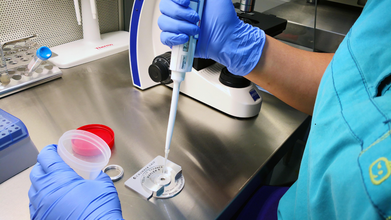- Health Conditions A-Z
- Health & Wellness
- Nutrition
- Fitness
- Health News
- Ayurveda
- Videos
- Medicine A-Z
- Parenting
- Web Stories
Fact Check: Semen Production Means You Have Healthy Sperms, Here's What The Doctor Says

Credits: Canva
Men's health is a topic often not talked about, however, it is as important as any other health related topics that are addressed more frequently. This is the case especially when it comes to men's reproductive health. While there has a been a lot of studies around semen production and what makes a sperm healthy, there are still many myths around it.
To burst one of such myths, we spoke to Dr Beena Muktesh, Senior IVF Expert at Motherhood Hospital, Gurugram. We asked her whether there was any truth in the claim that semen production is linked to healthy sperm.
Dr Muktesh points out that while sperm-related problems are rampant in men, many men still assume that producing semen automatically indicates fertility. "However, it is a myth that needs to be addressed." She says that there is a need to understand the difference between the two.
What Is Semen? How Does It Tell Whether The Sperm Is Healthy?
Semen is a fluid that is released during ejaculation. It contains sperm and other substances from the male reproductive organs. The sperm is around 1 to 5% of the semen. The rest of it is a liquid called seminal plasma, this includes water, proteins, enzymes, and nutrients like fructose for energy. It Is important for reproduction by helping sperm reach and fertilize the egg. "Healthy semen is pivotal when it comes to male fertility. However, a common myth among men is that if they ejaculate normally, their sperm must be healthy and fertile," she points out.
The doctor says that while semen production is sign that the reproductive system is functioning, it may not guarantee that the sperm it contains are capable of fertilizing an eff.
Dr Muktesh says, "Fertility depends not just on the presence of sperm but on their count, motility or movement, and morphology, or shape. Though many women do not know about this fact and continue to struggle in silence."
Semen that appears normal is volume, color and consistency, could still contain sperm that are low in number. They could move poorly, or have structural abnormalities, pointed out the doctor. "These factors impact the ability of sperm to reach and fertilize an egg, making conception difficult even if ejaculation occurs regularly."
The doctor suggests that men must undergo a semen analysis to evaluate their fertility. The analysis will be able to tell the number of sperm in a given volume of semen.
"Low count can reduce the chances of fertilization. The sperm motility will be checked to know how the sperm will move. Poor motility means sperm may struggle to reach the egg. The expert will also pay attention to the sperm shape and structure. Abnormal shapes can affect the ability to penetrate and fertilize the egg, and make conception challenging," she points out.
There are also other factors like the semen pH, volume, and white blood cell presence that could be monitored to detect infections or other underlying concerns. This is why it is important to get the analysis done and not just assume, she points out.
"Awareness and early evaluation allow timely intervention, increasing the chances of conception and promoting informed decisions about reproductive health. So, men, consult the expert without any delay and know about your sperm health status for healthy conception," she says.
Why Snatching the Phone May Not Be the Ultimate Parenting Tip for Teens

It’s almost a reflex action now - your teen seems distracted, moody or defiant and the first thing you reach for is their phone. Many parents believe that once the phone is gone, their child will start behaving better, focusing more and feeling calmer. But psychologists say this approach may be oversimplifying a complex emotional landscape.
The Real Issue: Teens Want to Be Understood, Not Controlled
Teenagers today are navigating a world far more layered than the one their parents grew up in. Their phones are not just gadgets, they are extensions of their identity, their social life and even their coping mechanisms. When parents link every behavioural problem to 'too much screen time' teens feel misunderstood and invalidated.
Also Read: Popcorn Brain: Is This Syndrome Behind Your Difficulty Concentrating? Experts Explain
“I am tired of being told that if I stop using my phone, I will feel better. My phone isn’t the problem, it’s how I connect with friends and keep up with what’s happening around me. Why should the rules be different for adults and for us?" says 16-year-old G. Kaur
This sentiment echoes across many teenage households - the need to be heard rather than judged. Their brains are still developing, firing signals of independence and identity formation, which often clash with parental control.
Why Parents React the Way They Do
For many parents, taking away the phone feels like the only available disciplinary tool. “Whenever I feel helpless about my son’s behaviour, my instant reaction is to taunt him about his phone usage or take it away,” admits one mother. “I know it is not right, but I don’t know what else to do. We grew up without phones and turned out fine but today’s kids just can’t seem to focus.”
This response, psychologists say, stems from fear and frustration. The digital world is unfamiliar territory for many parents, and snatching the phone feels like regaining control. But in reality, it often deepens the disconnect between parent and child.
Also Read: What Are Kratom And Kava, The Controversial Ingredients In ‘Feel Free’ Drinks?
What Psychologists Recommend Instead
First and foremost, understand the role of the phone. For teens, phones serve as social lifelines, a place where they explore identity, friendship and belonging. Dismissing that entirely can make them feel isolated. So instead of taking the phone away, have open conversations about how and why they use it.
Next focus on connection, not control. Rather than imposing blanket bans, set boundaries. For instance, agree on screen-free times during meals or before bed but let your teen be part of the decision-making. This gives them a sense of respect and control.
Also, look for the real reason behind behaviour. Irritability, withdrawal or lack of focus may not always be caused by phone use. These could be signs of stress, anxiety or emotional overwhelm.
Model healthy digital habits yourself. Teens mirror adult behaviour. If they see you constantly checking emails or scrolling late at night, they will assume it’s normal.
Keep an open communication. Teens respond better to empathy than authority. Simple statements like “I understand it’s hard to disconnect, even for me sometimes” or “I want to know what’s stressing you out” can make way for honest conversations.
In the end, parents need to understand that phones are not the enemy, disconnection is. When parents focus solely on controlling screen time, they risk missing the deeper emotional needs of their teens. Instead of snatching the phone, try reaching for understanding.
After all, the goal isn’t to raise a child who lives without a phone, it’s to raise one who can live well with it.
Teens Who Use Cannabis Are At Higher Risk Of Mental And Physical Health Problems Later In Life: Study

(Credit-Canva)
A new study showed that teens who begin using cannabis before the age of 15 are much more likely to face health problems later in life. Statistics show that many teens use cannabis, or substance more commonly known as weed from a young age.
The data from Government of Canada shows that 1 in 6 children from grades seventh to 12th reported using cannabis in 2014-15. They assessed that Canadian adolescents have the highest rates of cannabis usage.
The usage of cannabis at such a young age has also been linked to higher risk of using drugs later in life, according to the new study published in the JAMA Network Open. Compared to their peers who didn't use the drug in adolescence, they also face an increased risk of developing mental and physical health problems in young adulthood.
How Many Teens Use Cannabis?
This important conclusion comes from a recent study published in a science journal called JAMA Network Open. The researchers used data from a long study in Canada called the Québec Longitudinal Study of Child Development, where they have been following more than 1,500 children from when they were infants into their young adult years.
The scientists recorded many details about their lives, including if they used cannabis between the ages of 12 and 17. The study sorted the teenagers into three groups based on their habits:
Non-Users (60%)
Most of the teenagers didn't use cannabis at all during their adolescence.
Late/Infrequent Users (20%)
These teens started using cannabis later (in their late teens) and only used it rarely—less than once a month—by the time they were 17.
Early/Frequent Users (20%)
This last group started using cannabis before age 15 and used it at least once a month by age 17.
How Does Cannabis Usage In Teens Affect Health?
The group of teens who started early and used often was much more likely to visit the doctor or seek care for both mental and physical health problems as young adults.
Mental Health
These early/frequent users had a 51% higher chance of seeking professional help for mental health issues. This risk was calculated to be real even after the researchers carefully removed the influence of other factors that can affect health, like being bullied or problems at home.
Physical Health
Similarly, the same early and frequent users had an 86% higher chance of needing care for physical problems. The most common physical issues they reported were respiratory issues and getting into accidents or unintentional injuries. These issues could be related to being high/intoxication or perhaps to the body reacting when they stop using the drug, which are known as withdrawal symptoms.
Why Should Early Cannabis Usage Be Discouraged?
The Center of Disease Control and Prevention (CDC) explained that the brain of a teenager is still growing and developing a lot, and this process continues until they are about 25 years old. Using cannabis (marijuana) during the teen years and young adulthood can potentially harm this development.
Compared to teens who don't use cannabis, those who do are more likely to drop out of high school or not finish a college degree. Using cannabis can cause several immediate and long-term problems for teens
- Difficulty Thinking
- Memory Issues
- Poor Coordination
- Attention Problems
- School and Social Troubles
- Cannabis use can also lead to more serious issues that affect a teen's overall life.
- Increased Mental Health Risks
Cannabis is linked to depression and anxiety, and it raises the risk of temporary psychosis (paranoia or hallucinations). Starting young and using often increases the likelihood of long-term illness like schizophrenia.
Dangerous Driving
Driving under the influence of cannabis is illegal and unsafe, as it severely slows reaction time. Cannabis reduces coordination and concentration, impacting all the skills necessary for responsible and safe driving.
Potential for Addiction
Around 30% of cannabis users develop an addiction (cannabis use disorder). Failing to quit or choosing the drug over family activities are signs. This risk is higher for frequent teen users.
Tips For New Moms To Stay A Step Ahead Of Breast Cancer, According To Doctor

Credits: Canva
As a new mom a lot of things run through in the head. Not just child's health, but also your health too. As it is a very new experience. One of the newest experience could be breast feeding, and the thought of breast cancer and many such questions may occur.
Is There Any Link Between Pregnancy And Breast Cancer?
As per the National Institutes of Health, US, the risk of breast cancer, is in fact reduced by 4.3% for every 12 months of breastfeeding. This is in addition to 7.0% decrease in risk observed for each birth. However, notes a 2011 study published in the Journal of Turkish-German Gynecological Association, breast cancer risk is higher within the 3 to 15 years of term delivery. This increased risk is specific for women whose first delivery occurred after 30 years of age.
The study notes that women who delivered their fist baby at ages younger than 25, did not have any breast cancer risk, or had a very small increase. However, a transient increase was seen within 10 to 15 years of delivery and after that a protective effect of delivery is seen.
Among women who delivered their first baby before 25 years of age, the life time breast cancer risk actually decreased 36% after the period of transient increase.
However, new mothers who are at risk may find it difficult to distinguish between normal lactation-related issues and potential warning signs of breast cancer, including discharge from breast, and more.
To understand this better, we spoke to Dr Prachi Sarin Sethi, Gyencologist & Laparoscopic surgeon, Motherhood Hospitals, Gurugram. Here's what she told us:
"All new moms need to be aware that changes in the breast during lactation are common, but awareness is key," she pointed out.
Blocked Ducts And Mastitis Vs Suspicious Lumps: How to Differentiate?
"Many breastfeeding mothers experience blocked ducts, which can cause small, tender lumps in the breast," said Dr Sethi. To understand the symptoms, it is important to understand first what they mean.
Mastitis means an infection of the breast tissue that could lead to redness, swelling, warmth, pain, and even fever. "These conditions are temporary and resolve with rest, warm compresses, and proper breastfeeding techniques," she points out.
However, it is important to know that not all lumps are related to breastfeeding. Suspicious lumps can be hard, irregular in shape, painless, or persist beyond a week. This is when the woman must go to a doctor, she points out.
"Changes in the nipple, skin dimpling, or unusual discharge will also indicate that a woman needs medical attention."
The doctor notes that routine breast checks after the delivery must be done as it allows one's doctor to examine the breast tissue and guide the patient on proper self-examination techniques. This could also allow early identification of abnormalities, and improve the treatment outcomes.
"New moms should be encouraged to perform regular self-checks, observe changes in shape, texture, or skin appearance, and lumps. Keeping a record of any persistent changes or discomfort is helpful during consultations."
© 2024 Bennett, Coleman & Company Limited

